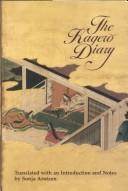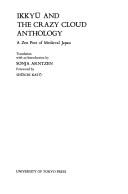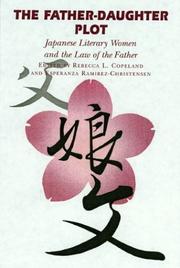| Listing 1 - 8 of 8 |
Sort by
|

ISBN: 0939512807 0939512815 0472127454 0472901400 9780472127450 9780472901401 9780939512805 Year: 1997 Publisher: Ann Arbor, Michigan : University of Michigan Press,
Abstract | Keywords | Export | Availability | Bookmark
 Loading...
Loading...Choose an application
- Reference Manager
- EndNote
- RefWorks (Direct export to RefWorks)
Japan is the only country in the world where women writers laid the foundations of classical literature. The Kagero Diary commands our attention as the first extant work of that rich and brilliant tradition. The author, known to posterity as Michitsuna’s Mother, a member of the middle-ranking aristocracy of the Heian period (794–1185), wrote an account of 20 years of her life (from 954–74), and this autobiographical text now gives readers access to a woman’s experience of a thousand years ago. The diary centers on the author’s relationship with her husband, Fujiwara Kaneie, her kinsman from a more powerful and prestigious branch of the family than her own. Their marriage ended in divorce, and one of the author’s intentions seems to have been to write an anti-romance, one that could be subtitled, “I married the prince but we did not live happily ever after.” Yet, particularly in the first part of the diary, Michitsuna’s Mother is drawn to record those events and moments when the marriage did live up to a romantic ideal fostered by the Japanese tradition of love poetry. At the same time, she also seems to seek the freedom to live and write outside the romance myth and without a husband. Since the author was by inclination and talent a poet and lived in a time when poetry was a part of everyday social intercourse, her account of her life is shaped by a lyrical consciousness. The poems she records are crystalline moments of awareness that vividly recall the past. This new translation of the Kagero Diary conveys the long, fluid sentences, the complex polyphony of voices, and the floating temporality of the original. It also pays careful attention to the poems of the text, rendering as much as possible their complex imagery and open-ended quality. The translation is accompanied by running notes on facing pages and an introduction that places the work within the context of contemporary discussions regarding feminist literature and the genre of autobiography and provides detailed historical information and a description of the stylistic qualities of the text.
Authors, Japanese --- J5630 --- J5923 --- Diaries --- Japan: Literature -- literary diaries, letters and accounts of travel --- Japan: Literature -- premodern fiction and prose -- Heian period (794-1185) --- Michitsuna no Haha, --- Diaries. --- Fujiwara Michitsuna no Haha, --- Fujiwara no Michitsuna no Haha, --- Fujiwara no Tomoyasu no Musume, --- Fujiwara Tomoyasu no Musume, --- Udaishō Michitsuna no Haha, --- Fujiwara Michitsuna no haha, --- 綱母, --- 藤原道綱母, --- 道綱の母, --- 道綱母, --- 道纲母,

ISBN: 0860083403 4130870491 9780860083405 9784130870498 Year: 1988 Publisher: Tokyo : University of Tokyo press,
Abstract | Keywords | Export | Availability | Bookmark
 Loading...
Loading...Choose an application
- Reference Manager
- EndNote
- RefWorks (Direct export to RefWorks)
Japonais (Langue) --- Zen poetry, Japanese --- Zen poetry, Japanese. --- Textes. --- Ikkyū, Sōjun,
Book
ISBN: 0231546823 9780231546829 Year: 2018 Publisher: New York, NY : Columbia University Press,
Abstract | Keywords | Export | Availability | Bookmark
 Loading...
Loading...Choose an application
- Reference Manager
- EndNote
- RefWorks (Direct export to RefWorks)
A thousand years ago, a young Japanese girl began a diary; from it, she skillfully created an autobiography later in life. This reader’s edition streamlines Sonja Arntzen and Moriyuki Itō’s acclaimed translation of the Sarashina Diary for general readers and classroom use, offering insight into the author’s world and the diary's textual history.
Authors, Japanese --- Women --- Human females --- Wimmin --- Woman --- Womon --- Womyn --- Females --- Human beings --- Femininity --- History --- Sugawara no Takasue no Musume,
Book
ISBN: 9780231167185 9780231537452 023153745X 0231167180 1322549354 Year: 2014 Publisher: New York ; Chichester, England : Columbia University Press,
Abstract | Keywords | Export | Availability | Bookmark
 Loading...
Loading...Choose an application
- Reference Manager
- EndNote
- RefWorks (Direct export to RefWorks)
A thousand years ago, a young Japanese girl embarked on a journey from the wild East Country to the capital. She began a diary that she would continue to write for the next forty years and compile later in life, bringing lasting prestige to her family. Some aspects of the author's life and text seem curiously modern. She married at age thirty-three and identified herself as a reader and writer more than as a wife and mother. Enthralled by romantic fiction, she wrote extensively about the disillusioning blows that reality can deal to fantasy. The Sarashina Diary is a portrait of the writer as reader and an exploration of the power of reading to shape one's expectations and aspirations. As a person and an author, this writer presages the medieval era in Japan with her deep concern for Buddhist belief and practice. Her narrative's main thread follows a trajectory from youthful infatuation with romantic fantasy to the disillusionment of age and concern for the afterlife; yet, at the same time, many passages erase the dichotomy between literary illusion and spiritual truth. This new translation captures the lyrical richness of the original text while revealing its subtle structure and ironic meaning. The introduction highlights the poetry in the Sarashina Diary and the juxtaposition of poetic passages and narrative prose, which brings meta-meanings into play. The translators' commentary offers insight into the author's family and world, as well as the fascinating textual legacy of her work.
Multi
ISBN: 9780231537452 9780231167185 023153745X Year: 2014 Publisher: New York ; Chichester, England : Columbia University Press,
Abstract | Keywords | Export | Availability | Bookmark
 Loading...
Loading...Choose an application
- Reference Manager
- EndNote
- RefWorks (Direct export to RefWorks)
A thousand years ago, a young Japanese girl embarked on a journey from the wild East Country to the capital. She began a diary that she would continue to write for the next forty years and compile later in life, bringing lasting prestige to her family. Some aspects of the author's life and text seem curiously modern. She married at age thirty-three and identified herself as a reader and writer more than as a wife and mother. Enthralled by romantic fiction, she wrote extensively about the disillusioning blows that reality can deal to fantasy. The Sarashina Diary is a portrait of the writer as reader and an exploration of the power of reading to shape one's expectations and aspirations. As a person and an author, this writer presages the medieval era in Japan with her deep concern for Buddhist belief and practice. Her narrative's main thread follows a trajectory from youthful infatuation with romantic fantasy to the disillusionment of age and concern for the afterlife; yet, at the same time, many passages erase the dichotomy between literary illusion and spiritual truth. This new translation captures the lyrical richness of the original text while revealing its subtle structure and ironic meaning. The introduction highlights the poetry in the Sarashina Diary and the juxtaposition of poetic passages and narrative prose, which brings meta-meanings into play. The translators' commentary offers insight into the author's family and world, as well as the fascinating textual legacy of her work.
Literature --- Authors, Japanese --- Sugawara no Takasue no Musume --- Sugawara no Takasue no Musume,
Book

ISBN: 9780824864712 Year: 2001 Publisher: Honolulu
Abstract | Keywords | Export | Availability | Bookmark
 Loading...
Loading...Choose an application
- Reference Manager
- EndNote
- RefWorks (Direct export to RefWorks)


ISBN: 9780824864712 9780824821722 Year: 2001 Publisher: Honolulu, Hawaii University of Hawaii Press
Abstract | Keywords | Export | Availability | Bookmark
 Loading...
Loading...Choose an application
- Reference Manager
- EndNote
- RefWorks (Direct export to RefWorks)
Book

ISBN: 023113696X Year: 2007 Publisher: New York Columbia university press
Abstract | Keywords | Export | Availability | Bookmark
 Loading...
Loading...Choose an application
- Reference Manager
- EndNote
- RefWorks (Direct export to RefWorks)
J5511 --- J5700 --- J5920 --- J5910 --- Japan: Literature -- collections, series and anthologies -- premodern, earliest to Edo ( -1868) --- Japan: Literature -- poetry in general --- Japan: Literature -- premodern fiction and prose ( -1868) --- Japan: Literature -- fiction and prose -- anthologies, selections, series, sōsho --- Japanese literature
| Listing 1 - 8 of 8 |
Sort by
|

 Search
Search Feedback
Feedback About UniCat
About UniCat  Help
Help News
News